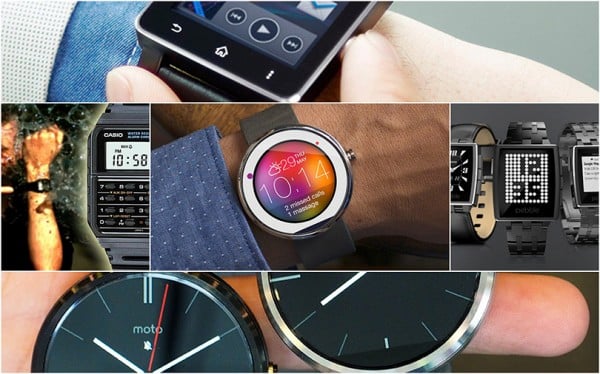These days, it’s difficult to imagine
a world without smartphones. They give us access to the internet wherever we are, tell us where to go via GPS, let us know the time, and are even used to make an old fashioned phone call in between taking selfies. How did we ever live without them?
Smartphones also took some tech companies by susprise, like Nokia for example. A company which completely dominated the mobile phone market at one point, completely lost its footing as they missed the smartphone boat. Now, possibly worried about missing another boat, many companies are jumping into making smartwatches. It’s a watch which is… smart. Sort of.
![]()
A smartwatch eliminates regular watch components and replaces it with an LCD panel and some electronics which add up to a very limited miniature computer. It can then communicate with your smartphone, so it can not only show you the time but also who just sent you a message and what the weather is going to be like tomorrow. Basically, you can now run apps on your wrist instead of in the palm of your hand — what a breakthrough.
Are they the next big thing? At the risk of looking like an idiot in 5 years time, I’m going to say no. In the future, this article could get deleted and I may claim I never wrote it, so you might want to save it just in case you want to rub my nose in it later on. Still, I’m pretty confident that whatever happens these smartwatches are going to need to change quite a lot in order to catch on.
![]()
The first problem is that, with current technology, they are just completely pointless. At best they are an extention of your smartphone, at worst they do nothing but duplicate some functionality of the device you already have with you all the time. The sizes are pretty large for a watch but even so there’s not much room for a screen, which tends to be square. The second problem is that smartwatches somewhat miss the point of wearing a watch. The Swiss watch industry does not make billions of dollars because people need to have the time on their wrist. People buy expensive watches the same way they buy jewelry. They buy it for how it looks, and for what it says about the person wearing it. An expensive mechanical watch is still worse at keeping correct time than a cheap battery powered one. Nobody cares.
Talking about batteries, I don’t think anyone is really waiting for a watch that needs to be recharged almost as frequently as your phone. A large screen with pretty graphics is always going to need a lot of electricity to run, which means you’ll be charging your smartwatch pretty much every night. Not the largest invonvenience of course, but remember that rechargable batteries wear down each time you recharge them. After about a thousand recharge cycles, the battery will definitely be toast. The 500-year old technology in my mechanical watch can last longer than a human lifetime, with a bit of lubrication once every decade or so. So much for progress.
I do believe there is a definite opportunity for smartwatches to be cool, at least for a period of time until they become too commonplace. Some people just like to be different, and there is no doubt that your latest smartwatch can get you more attention in the local pub than a vintage Heuer chronograph only watch geeks would recognize. It’s like those calculator watches back in the 80s — which also tried to solve a problem that didn’t exist. Mind you, as a 10-year old I thought they were awesome and I just had to have one, because it looked so cool and would surely come in handy at the next math test at school. Of course once I had one I never used it for calculating anything, as the buttons were too small even for a 10 year-old’s fingers. Of course, if you wear a 25-year old calculator watch today that’s pretty cool and vintage because no-one else has one. Funny old world isn’t it.
![]()
For those of you who are looking to capitalize on the novelty factor of these watches, I should probably leave you with a couple of recommendations, so here we go.
Sony currently has a model on sale which is aptly called the SmartWatch 2. No prizes for guessing what the first one was called. It’s a square watch with a 1,6 inch touchscreen and you can link it to any recent phone running Android. It has a bit of a generic appearance if you ask me, the watch itself looking almost as unimaginative as the name it carries.
![]()
Infinitely nicer to behold is the new Moto 360 from Motorola. It’s round for a start, which is something we have apparently been taking for granted with classical watches. A round screen is a lot more difficult to make than a square one, but Motorola have done well here. This is a great looking watch by any standard, and it has a genuine quality appearance unlike some of the more plastic looking smartwatches out there. If you’re a bit of a hipster, this one could work well for you.
![]()
![]()
But, the coolest kid on the block has to be the Pebble. The company was started with crownfunding on Kickstarter, and it was a success from the start as they pre-sold 68 thousand watches for over 10 million dollars in funding. Its technical specifications are not the highest, but its firmware can be updated and its custom Pebble OS can communicate to both iOS and Android through respective apps. There’s a Pebble Steel edition, which comes on a nice steel bracelet instead of the regular plastic.
![]()
None of these watches are actually terribly expensive, at least until Apple releases one — which they are expected to do before the end of the year. It’ll be interesting to see if Apple manage to see the forest for the trees as they did with the original iPhone. If they do, then maybe there is hope for smartwatches after all. Otherwise, it’s not very likely anyone will still be wearing them in 10 years’ time. They might in 30, though.

Last article
Mecanisms with Jan Coomans. Porsche the Great in St. Petersburg
Photo Jan Coomans
A long time ago, when I was a kid with pictures from car magazines
plastered all over my bedroom walls, the name Porsche was pretty much synonymous with the 911. Sure they also had the 944 and 928 in their showrooms at the time, but there was never any doubt which was the real, quintessential sportscar from Porsche.
Since then, the Porsche brand has grown enormeously — and so has their lineup. You can buy an SUV from Porsche these days. Even with a diesel engine, if you want to. And there’s also the Panamera, a large 4-door saloon. There is no doubt that both these cars are among the very best in their segment, but clearly they are not sportscars and sportscars is what Porsche do best. So, the latest 911 must be really good. And indeed it is. But as a thoroughbred sportscar it is now facing increasingly strong competition from an unexpected corner.











